23.03.2006
N.Vitiugov. Portrait of a chessplayer - Alexander the Great, part II
The way up
I remember that I announced the possible didactic use of this work for the young chess players. Let's sort it out together. How does a chessplayer get in to the notorious elite? First, it seems that he should be young. He must have a certain talent. He must also have certain results. It is desirable to have "salt" in his play, though the opposite tendency is being proved nowadays. I don't know what else is to be added. Anyway, in his time Alexander had everything of the afore-mentioned but he was only approaching the summit for some time. Perhaps, there is a moment in the career of any outstanding sportsman when it is necessary to show some result or to win an important tournament to advance to a new level. Otherwise the sportsman risks gradually loosing his skill, failing to justify hopes and turning into a casual player. The championship of Russia in 1998 became such a boundary for the Muscovite. But how can one get to this transitional stage? How can a chessplayer turn from a gifted youth into a strong player with the rating over 2600? The best trainers of the country puzzle over this question. The author will only note that Morozevich didn't prepare the novelties on the twenty-fifth move for this purpose. He only developed some schemes that were considered to be doubtful and unpretentious and he gained a lot of points playing them. There are two reasons of this phenomenon. They are: Alexander's strong play and the opponent's poor preparation for the eccentric opening chosen by the Muscovite. That is the approach.
A.Morozevich (2605) – V.Anand (2715) C33
Moscow 1995
This is a legendary victory of young Morozevich over Anand that was gained in Hollywood style – dashing and "bridge-burning".
1.e4 e5 2.f4

Tell me please, is it possible not to give a diagram of this position? The young chessplayers' approach to chess work can be described using a phrase by Vladimir Il'ich [Lenin]: "Study, study and study!" What for? Why? All these questions have suddenly become too difficult. The main thing is to learn as much theory as possible. So I want to cry out: "When you play chess, play it! You can contend in the memory capacity in other fields. For example, in the declamation of poems".
2...exf4 3.Ґc4. A dashing approach. White gave a pawn away and is about to forfeit castling on the forth move.
3...¤f6. The other way is 3...Јh4+ or 3...d5 4.Ґxd5 ¤f6 5.¤c3 Ґb4 6.¤f3 0–0 7.0–0 c6 8.Ґc4 Ґg4 9.d3 ¤h5 10.¤e2 ¤d7 11.c3 Ґa5 12.d4 c5 13.¤xf4І, Morozevich – Almasi, Monaco 2002.
4.¤c3 c6. This is a debatable plan. Black carries out d7-d5 but by this he actually only creates a weakness, though he also restricts the White's bishop.
5.Ґb3 d5 6.exd5 cxd5 7.d4 Ґb4 8.¤f3 0–0 9.0–0 Ґxc3 10.bxc3 Јc7 11.Јe1
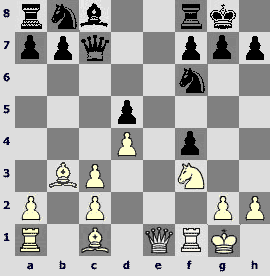
It is impossible to say that White has a considerable advantage in this position but I think that it's possible to admit that the opening developed in favor of White. He could play a bit more modern: 11.Јd2!?
11...¤c6 12.Јh4 ¤e7 13.Ґxf4. A questionable decision, though a principled one. 13.Ґxf4!?
13...Јxc3 14.Ґd2. However, I consider 14.Ґg5!? ¤f5 15.Ґf4 ¤e4 16.Ґxd5 ¤xg5 17.¤xg5 ¤xd4 18.Ґxf7+ ўh8 19.ўh1І to be more promising.
14...Јc7 15.¤e5 ¤f5 16.Јf4 Ґe6 17.Ґb4 ¦fc8 18.g4 ¤d6 19.¦ae1

White disposed his pieces as aggressively as possible and gave up the pawn on the way. Time to burn!
19...¤fe4 (19...a5 is not very useful: 20.Ґxd6 Јxd6 21.g5 ¤e4 22.c4 dxc4 23.Ґc2ѓ) 20.c4. Sawing a bough the e4-knight is sitting on.
20...dxc4. 20...¤xc4? 21.Ґxc4 Јb6! 22.¦xe4! dxe4 (22...Јxb4? 23.¤xf7ќ) 23.Ґxe6 Јxd4+ 24.ўh1 fxe6 25.Јf7+ ўh8 26.Јxe6± leads to a very difficult position.
21.Ґc2 ¤f6? Thisis a concession. It is either the effect of underestimating the opponent who was young at that time or the pressure natural for the time control used... 21...Јb6!?› kept the tension.
22.g5 ¤h5? And this move loses. The classics were wise indeed. There was a good reason for Tarrasch to speak about bad knights... The black's knight had to rush to the centre – 22...¤d5 23.Јh4 (it was a feverish haste 23.Ґxh7+? ўxh7 24.g6+ ўg8 25.Јh4 fxg6 26.Ґxd6(it is better to play26.¤xg6!? ¤f7 27.¦xe6 ¦e8і,but here the White's position is simply bad) 26...g5!° 27.Јh5 Јxd6 28.¤g6 ¤f4) 23...g6
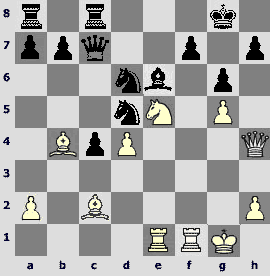
24.¤xg6! (weaker is 24.Ґxd6 Јxd6 25.¤xf7 Ґxf7 26.¦xf7 h5!›)24...fxg6 25.¦xe6 ¤xb4 26.Ґxg6 Јg7 (26...¦f8!? 27.¦xf8+ ¦xf8 28.¦xd6 e7 (28...c3? 29.Јh6ќ; 28...Јg7? 29.Јh5ќ) 29.¦e6 Јg7›, this variation is also possibleand the position remains difficult) 27.¦xd6 hxg6 28.Јe1!‚
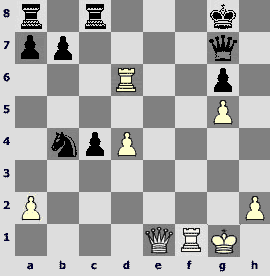
White keeps the initiative and wins back the material.
23.Јf3 g6 24.¤xg6!ќ
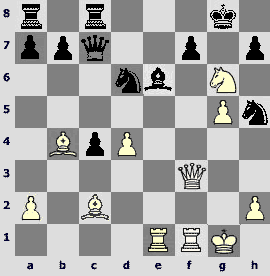
In the bull's eye!
24...hxg6 25.Ґxg6 fxg6. 25...¤g7 also loses because of 26.Ґxd6 Јxd6 27.Ґxf7+ Ґxf7 28.Јxf7+ ўh8 29.¦e4.
26.¦xe6 Јf7 (26...Јg7 27.Ґxd6; and there is an interesting variation after 26...¦f8 27.¦xg6+ ¤g7 28.Јxf8+! ¦xf8 29.¦xf8+ ўxf8 30.Ґxd6+ Јxd6 31.¦xd6ќ) 27.Јd5 ¤f5 28.¦xf5!
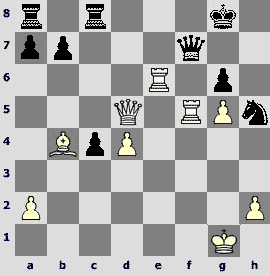
1–0. It seems to me that in such cases the fact of the victory and the style of this victory are equally valuable.
K.Sakaev (2620) – A.Morozevich (2590) D17
Kishinev 1998
1.d4 d5 2.c4 c6 3.¤f3 ¤f6 4.¤c3 dxc4 5.a4 Ґf5 6.¤e5 ¤bd7 7.¤xc4 Јc7
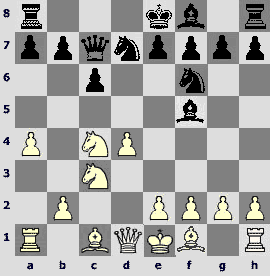
The openings of Morozevich's games can be easily annotated basing only on his own games. This is what we're going to do in the following case. 7...¤d5 8.g3 e5 9.Ґg2 exd4 10.Јxd4 Јf6 11.Јxf6 ¤7xf6 12.¤xd5 cxd5 13.¤e3 Ґe6 14.0–0 Ґc5= Kasparov – Morozevich, Astana 2001.
8.g3 e5 9.dxe5 ¤xe5 10.Ґf4 ¤fd7 11.Ґg2 f6 11...g5 12.¤e3 gxf4 13.¤xf5 0–0–0 14.0–0 fxg3 15.hxg3 ўb8 16.¦c1 ¤c5 17.Јc2 a5 18.¦fd1 ¦xd1+ 19.¦xd1 ¤e6 20.¤e4 Ґb4 21.¤f6 ¦d8› Shirov – Morozevich, Monte Carlo 2005.
12.0–0 ¤c5!?¤. At that moment it was a novelty. Black moves his knight on an active position and vacates the d-file for the rook. It is a very good move even from the point of general considerations.
13.e4. White begins advancing his pawns in the centre. Other options are – 13.¤xe5!? fxe5 14.Ґe3 ¦d8 15.Јe1 Ґe7 16.¦d1›; 13.b4 ¦d8 14.Јc1 ¤e6=; 13.Јd4?! ¤b3 14.Јe3 Ґc5!
13...Ґg6 14.Ґxe5? It is a too zealous attempt to refute all the opening strategy of Black. Probably, the most acceptable was 14.Јe2!?›. 14.b4 ¦d8 15.Јc2 ¤e6 (15...¤cd3 16.¤xe5 fxe5 17.Ґg5 Ґe7і)16.Ґxe5 fxe5 17.¦ab1 Ґe7і is weak and if White plays 14.¤xe5 fxe5 15.Ґe3 the best way that was given by Alexander himself is 15...Ґe7 16.b4 ¦d8 17.Јc2 ¤e6 18.Ґh3 ¤d4 19.¤b5 Јb6 20.¤xd4 exd4 21.Ґd2 d3і Iskusnyh – Morozevich, Maikop 1998.
14...fxe5 15.f4 ¦d8 16.Јg4? In the same aggressive style. White approaches the problem very straightforward and with the excessive zeal. 16.Јe2!? with a sample line 16.¤b3 17.¦ad1 Ґc5+ 18.ўh1 ¤d4 19.Јg4 exf4 20.gxf4 0–0 21.¤e5 Ґe8 22.¤d3 Ґb6› was more in the spirit of the position. 16.Јc2 exf4 17.gxf4 ¤e6 18.f5 Ґc5+ 19.ўh1 ¤d4і is a bit more passive.
16...exf4 17.gxf4 ¤d3. Black enters the vacant square. 18.ўh1 Ґc5. Black plays with ease and believes in his position. And he is absolutely right.
19.f5 Ґf7
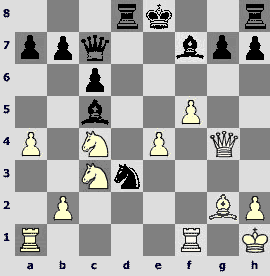
The position is approaching the climax. Both players gradually carry out their plans. White advances the pawns in the centre. Black, in his turn, plays with pieces and also in the centre.
20.e5. White's pawns force their way to promotion squares. A principled 20.Јxg7 ran into a firm response 20...¦g8, and the Black's pieces develop a dangerous activity (20...Ґd4? 21.e5! ¦f8 22.¤e4!ќ)21.Јxh7 Јd7! 22.¤d2 (22.¤a3 is followed by a beautiful variation 22...Јd4 23.Јh4 ¦g4!! – the diagram)
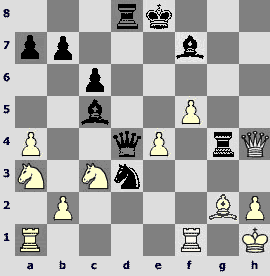
22...Јd4 23.¤f3 ¤f2+ 24.ўg1 (24.¦xf2 Јxf2 25.¦g1 ¦d3°) 24...Јb4µ.
20...Ґxc4! 21.f6!? A principled response.White undertook certain obligations by his play and it is too late to retreat. Simple 21.Јxc4 led to a worse position– 21...Јxe5 22.¤e4 ¦d4 23.Јc3 ¦xe4 24.Јxd3 ¦e3 25.Јc4 Ґd6 26.Јh4 0–0µ.
21...Јxe5?! This logical queen centralization could run into a firm and straightforward response of the opponent.Alexander in his notes considers centralization of another heavy piece to be the strongest : 21...¦d4! 22.fxg7 (22.¤e4 gxf6!?)22...¦g8 23.Јh5+ Ґf7 24.Јxh7 Јxe5°, though there were other ways, for example, 21...¤xb2!?
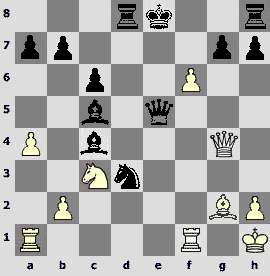
22.¦f5?
Konstantin doesn't use the opportunity. Also 22.fxg7 ¦g8 23.Јxc4 ¦xg7µ doesn't help, but the solution is quite simple - 22.Јxg7! ¦f8 23.¦ae1 ¤f2+ (it is possible that here Black has to play 23...Јxe1 24.¦xe1+ ¤xe1 25.Јxh7 ¦xf6 26.Јh5+ Ґf7 27.Јxc5›), and here a cool 24.ўg1! saves White. The discovered check isn't dangerous – 24...¤g4+ 25.ўh1 Ґe3 26.Јxg4 Ґxf1 27.¦xf1©.
22...Јe6 23.fxg7 ¦g8 24.Јh5+. On 24.¤e4 Ґe7 25.¦af1 the demarche of the Black's king finally defines the assessment of the position: 25...ўd7!°.
24...Јg6 25.Јe2+. An agonizing check. The last chance, if this word is suitable in this position, is 25.¦xc5!? Јxh5 26.¦xh5 ¦xg7°.
25...Ґe7 26.¦f8+ ¦xf8 27.gxf8=Ј ўxf8 28.Ґe4 Јf7
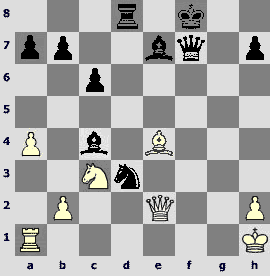
0–1. The author used comments by A. Morosevich published in the third issue of 64, 1998.
It is one of the most important games in Alexander's life. Following this win he became a champion of Russia.
A.Morozevich (2625) – S.Rublevsky (2685) B40
St.Petersburg 1998
1.e4 c5 2.¤f3 e6 3.¤c3. Alexander has scored many points in the Closed Sicilians, but there were few wins as important as this one.
3...a6 4.g3 b5 5.Ґg2 Ґb7 6.d3

6...d6. 6...Ґe7 7.0–0 ¤f6 8.e5 is worse and after these moves Black's position is rather difficult: 8...¤d5 9.¤e4 ¤b6 10.¤fg5ѓ V. Popov – Vitiugov, St.Petersburg 2005.
7.0–0 ¤f6 8.¤g5 b4 9.¤e2 Ґe7 10.f4 d5. Black carries out a thematic d5 with a loss of tempo.
11.e5 ¤fd7 12.¤f3 ¤c6 13.c4. It is an interesting approach.As a matter of fact, one is not supposed to play on the opponent's wing but here this advance isn't unreasonable. Black is either to decide about the centre or to open the b-file for the rooks.
13...bxc3?! Keeping the beauty of the centre, Black makes a very responsible decision. The b-file and a free access to the queenside of the White's queen will halloo to him not once. In my opinion, it was more flexible to play 13...¤b6.
14.bxc3 a5 15.¦b1 ¦b8 16.f5!?
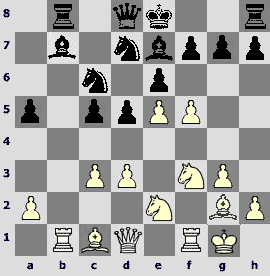
White challenges a key point of Black's position – the e6-pawn. However, this move is natural and isn't worth of much pathos.
16...Ґc8. The reply is solid.Surely, the central pawn is very important, but it was impossible to take it – 16...¤dxe5 17.¤xe5 ¤xe5 18.fxe6 fxe6 19.Ґh3 d4 (19...Јd6 20.Ґf4±) 20.Ґf4І. If Black responds 16...exf5 the opening of the b-file can tell on – 17.Ґf4! g5 18.e6 gxf4 19.exd7+ Јxd7 20.¤xf4 0–0 21.¤d2 ¤e5 22.Јh5ѓ.
17.¦xb8 ¤dxb8 18.fxe6 Ґxe6. It is natural that Rublevsky didn't want to put himself in an absolutely passive position. 18...fxe6 19.Ґh3 ¤a6 20.¤f4 ¤c7 21.¤g5! and Black feels worse from move to move.
19.¤f4 0–0. The bishop must close itself the breach in the chain of pawns, it can't leave – 19...Ґg4 20.h3 Ґxf3 21.Јxf3 ¤xe5 22.Јe2 ¤bc6 23.¤xd5±.
20.¤xe6 fxe6 21.Ґf4. White has better prospects. He has an object to attack and the b-file, and if the worst comes to the worst, he has the advantage of two bishops.
21...¤a6. Sergey played the whole game in a straight and deliberate style. However, wasn't it worth trying a dashing 21...g5!? 22.Јa4 Јd7 (22...Јb6!? 23.Ґh3 ¤c7І) 23.¦b1 ¦b8 24.¦xb8+ ¤axb8 25.Јb5І
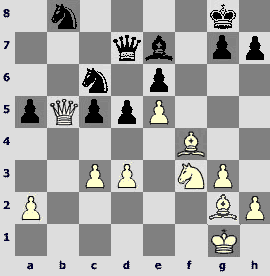
The author is prone to suppose that in the position on the diagram White has a comfortable and clear advantage. Black must defend passively.
25...Јc8 26.c4 Јa6. Black exchanges the pieces very consistently. Nothing remains but to make these exchanges. White shouldn't avoid the exchanges in accordance with the precepts of the classics. He only needs to carry them out in the most advantageous way.
27.Ґh3 ўf7 28.Јb1. White uses the fact that the Black's king went on the main road and refuses exchanging the queens.
28...dxc4. Black turns to active counterplay (although, how can the counterplay be passive?).
29.dxc4 Јxc4 30.Јxh7 ¤d4. Black gets rid of one of the knights that duplicate each other. Taking the pawn is tempting but weak – 30...Јxa2 31.Ґh6‚.
31.Јh5+ ўf8. No matter how good is 31...g6!? objectively, it is very difficult to decide about giving up a pawn with check in the endgame. 32.Јh7+ ўe8 33.Јxg6+ ўd7,

and although in both variations given below the position is unclear, I think that White has better chances everywhere: 34.¤xd4 (34.Јg4 ¤e2+ 35.ўf2 ¤xf4 36.Јxf4 Јxa2+›)34...Јxd4+ 35.ўf1 Јa1+ 36.ўe2 Јxa2+ 37.Ґd2 ¤c6›.
32.Ґf1 ¤xf3+. Black could press on the White's knight by 32...Јd5, but then after the series of checks 33.¤xd4 Јxd4+ 34.ўg2 Јd5+ 35.ўh3І the White's king would run on h3.
33.Јxf3 Јd5™ 34.Јxd5 exd5
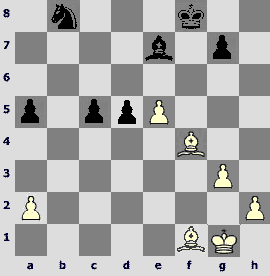
The Muscovite managed to go to the endgame with two bishops but he had to pay the worth – now Black has connected passed pawns. The next move fixes the White's initiative.
35.Ґb5! g5?! A paradoxical 35...c4!? was actually a good chance, and now, in case of 36.e6 c3 37.Ґxb8 c2 38.Ґf4 Ґa3, the ending is clearly drawn.
36.Ґd2 Ґd8? In fact, this is a decisive error. It was necessary to neglect the pawn in order to coordinate his pieces: 36...ўf7 37.Ґxa5 ўe6›.
37.e6. Now the Black's king can't go out. 37...c4 38.ўf1 a4 39.ўe2 Ґf6 40.Ґb4+ Ґe7 41.Ґa5 Ґd6 42.Ґd8 g4 43.e7+!
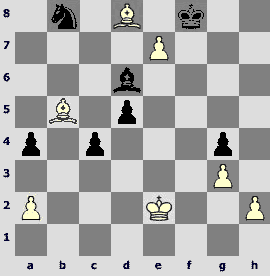
That is a very simple distraction. 43...Ґxe7 44.Ґc7. Black gave up. It is one of the most important victories.
"Well, blow it up..."
Gradually the chess players with ELO 2700+ got accustomed to unusual play of Alexander. They either solved or just luckily guessed his riddle right, but at some point the results of the idol of many fans caused certain fears. And then Alexander received the invitation to San Luis, the tournament that seemed to be suitable for the irregular style of Morozevich. Basically, there were two places in it – the first one and the others. It resulted in nervous play, absence of habitual fireworks, even certain positional rightness and prudence and, consequently, two defeats playing with the white pieces. And one must fight for the first place! In this situation Alexander begins to play chess like a genius. The heading of this part can be a motto of his performace. He didn't want to beat his opponents in a long and tense struggle. He started playing extremely provocatively from some point in every game. The idea is absolutely right – the opponent also needs points in such tournament. Maybe he needs them even more than you need. So for sure he will start playing for a win and won't be able to stop.
A.Morozevich (2707) – P.Leko (2763) B33
San Luis 2005
1.e4 c5 2.¤f3 ¤c6 3.d4 cxd4 4.¤xd4 ¤f6 5.¤c3 e5. Everything changes. There were days when Morozevich avoided playing the Sveshnikov variation.In this case he decided to play a rare variation that leads to a maneuvering struggle without any advantage.
6.¤db5 d6 7.Ґg5 a6 8.¤a3 b5 9.¤d5 Ґe7 10.Ґxf6 Ґxf6 11.c4
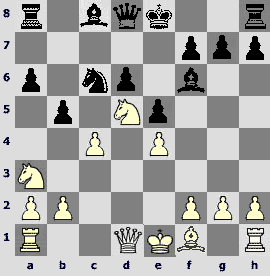
11...b4 12.¤c2 ¦b8 13.b3. White closes the queenside. Everything is to be decided in the middlegame. In September 2005 in the Highest league Vadim Zvjaginsev tried 13.g3, but he didn't succeed either: 13...0–0 14.b3 Ґe6 15.¤xf6+ Јxf6 16.Ґg2 Јe7 17.0–0 a5 18.f4 Ѕ–Ѕ Zvjaginsev – Najer, Kazan 2005.
13...Ґg5 14.g3 0–0 15.h4 Ґh6 16.Ґh3. Attempting to exchange a good bishop of the opponent. 16...Ґe6. But itisn't so easy! Black will exchange only under favorable circumstances.
17.ўf1 a5 18.ўg2 ¦b7 19.Ґf5 ўh8

What should White do now? How can he break Black's defense? The Muscovite decides to put his pieces in the center trying to provoke some activity of the opponent.
20.Јd3 ¤b8 21.¦ad1 ¤a6 22.Јf3 g6 23.Ґh3 f5 24.h5. White initiates counterplay - Black already has the initiative. 24...fxe4 25.Јxe4 ¤c5 26.Јe2 Ґxd5+. Black gives the bishop for the strong knight and wins time for developing the initiative. His is structurally worse but dynamical factors are on his side.
27.¦xd5 ¦bf7 28.¦f1
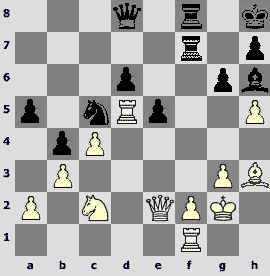
28...gxh5. Another example of concrete approach. Black finally spoils his pawns but entices the white queen under attacks. tone could also play 28...Јf6!?
29.Јxh5 Јf6 30.Ґg4. White covers the g-file and at the same time prepares f3. 30.Јe2 Јg6! would have been a significant concession.
30...¤e4 (30...¦g8!?) 31.f3 Јg7 32.¦dd1 (32.Јh3 ¤f6 33.¦dd1 would only change the order of moves) 32...¤f6 33.Јh3 ¤xg4 34.Јxg4 Јf6. This is correct – the endgame is equal. The chance of Black consists in a weak position of the White's king.
35.Јe4
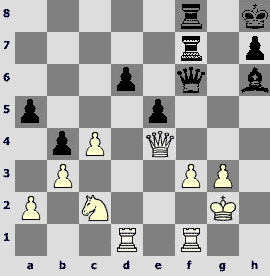
35...Ґf4?
How to refrain from such move? Even if you play in the World championship, even if it is not in your style... The opponent mishandled the game, right? However, a calm 35...¦g8 36.¦h1 (36.¤e3?! Ґxe3 37.Јxe3 ¦fg7 38.g4 h5‚)36...Ґf4 37.¦h3 ¦fg7 38.g4і is stronger.
36.ўf2. It is impossible to take the bishopat once: 36.gxf4 Јh4 37.¦f2 ¦xf4 38.Јe3 e4ѓ, and Black has powerful initiative. For example, 39.¤e1 exf3+ 40.¤xf3 Јg4+ 41.ўh1 ¦xf3 42.¦xf3 ¦xf3.
36...Јh6. Consistent: Black leaves the bishop en prise and believes in the power of his own attack.
37.gxf4 ¦xf4 38.¦h1. A very important intermediate move. 38...Јg7 (38...Јxh1 39.Јxf4!) 39.Јd5 e4?! A mistake. after which Black's position becomes hopeless. However that may be, but it was necessary to play 39...¦xf3+ 40.Јxf3 ¦xf3+ 41.ўxf3 e4+! 42.ўxe4 Јg6+ 43.ўe3 Јxc2 44.¦xd6±. Of course, the arisen position favors White, but it is yet to be won. However, it seems that Peter was overwhelmed with emotions.
40.¦dg1 ¦xf3+ 41.ўe2 ¦f2+ 42.ўd1 Јe5 43.¦h5 ¦f1+ 44.¦xf1 ¦xf1+ 45.ўe2 Јf4 46.Јd4+ ўg8 47.¦g5+!ќ

A decisive check. White has an extra knight and a winning position. The game continued 47...Јxg5 48.ўxf1 Јc1+ 49.¤e1 Јf4+ 50.ўg1 Јg5+ 51.¤g2 Јc1+ 52.ўh2 Јh6+ 53.ўg3 Јg5+ 54.ўf2 1–0
R.Kasimjanov (2670) – A.Morozevich (2707)
San Luis 2005
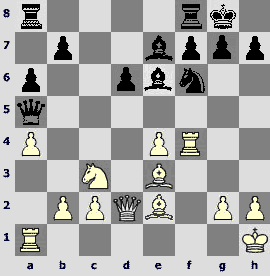
It is a typical Sicilian structure. Even a first-category chess player knows that Black should exchange dark-squared bishops. It is also known that weakness of the d6-pawn is compensated by weakness of White's e4-pawn. However, as far as I know, the maneuver carried out by the Russian is novel.
15...¦fc8 16.¦d1 Ґd8 17.¦ff1 Ґb6. Three moves and Black realized his main idea at the cost of his a8-rook being rather cramped.
18.Ґd4 (18.Ґg5 is met by a typical Sicilian stroke: 18...¦xc3!) 18...Ґxd4 19.Јxd4 ¦c6
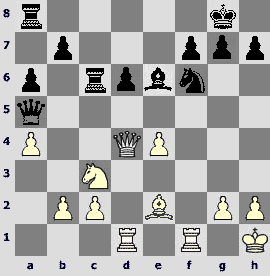
A colossal dualism is concealed in this move. On the one hand, it is sensible – Black defends a pawn, but on the other hand, how can one move under attack so eagerly?
20.¤d5 Ґxd5 21.exd5 ¦cc8. Alexander presented White with two tempi – it was a broad gesture. No he wonders how White can utilize them. Rustam reasonably decides that it is time for a direct attack – in addition, all Black's pieces are badly misplaced. It sounds cynically but I haven't found anything decisive after a shameless 21...¦xc2 22.Ґd3 ¦cc8 (22...¦c7 23.Јh4 ¦e8 24.¦xf6 gxf6 25.¦f1‚)23.¦xf6 gxf6 24.¦f1 ¦e8 25.b4© – in all the variations White only has compensation. In other words, there is everything to play for.
22.¦xf6 gxf6 23.Ґd3 ¦e8 24.Јh4 ўf8
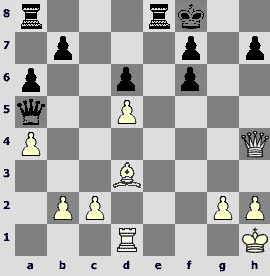
It is a very important moment. The players made a couple of natural moves. The value of each move is utterly high. It seems that White has more than sufficient compensation, but everything must be proved.
25.¦f1?! An absolutely sensible idea to bring up the rook turns out to be not the best decision. The loss of the d5-pawn hits White very seriously. Of course, it is funny but he had to turn to a positional game, and start with25.Ґxh7!? ¦e5 26.b4 Јd8 27.a5!І
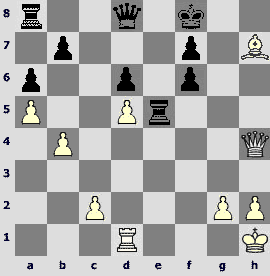
The White's play in this variation looks anecdotal, but why not? By the way, I think that White has an advantage in this position.. (27.¦f1!? a5 28.b5).
25...Јxd5 26.Јh6+? And this is a serious error. It was impossible to let the Black's king out to d7. It was stronger to play 26.Јxf6! Јe6 27.Јh8+ ўe7 28.Јd4 Јe5 29.Јb4ѓ, and White goes in from the other side.
26...ўe7 27.Јxf6+ ўd7 28.h3. Was it necessary?It will be attacked in a few moves. I suggest 28.b4!?
28...h5 29.b4 ¦e3. Black forces the White's reply. 30.¦f5 ¦e5 31.¦xe5. Avoiding the exchange makes no sense – 31.¦f3 ¦ae8µ.
31...dxe5
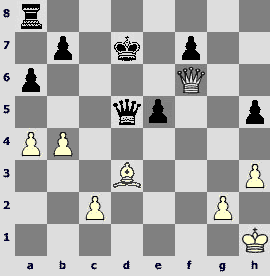
32.Јf5+?! This move allows Black to restrict the White's bishop seriously.There were more problems for Black after 32.Јf5+ ўc7 33.c4 Јd1+ 34.ўh2 Јd4 35.Јxf7+ ўb6і, though his position is still better.
32...Јe6 33.Јxh5 e4 34.Ґe2 ¦f8?! It is the first inaccuracy of Morosevich in this game. He should have carried out the advance 34...f5!? immediately.
35.b5? Apparently, Kasimjanov was already in a time trouble and overlooked the opportunity to complicate the struggle. He could activate the queen – 35.Јc5!?, and it is not easy for Black to play.
35...f5µ

The position assumed a technical character. A bit nervous checks of White in the time trouble didn't change anything. And now come back to the first diagram and appreciate provocative character of Black's play. It went with the sensible ideas very subtly.
36.bxa6 bxa6 37.Јh7+ Јf7 38.Јh6 Јf6 39.Јh7+ ¦f7 40.Јg8 ўe7 41.Ґc4 ¦f8 42.Јh7+ ўd6 43.Јb7 Јa1+ 44.ўh2 Јe5+ 45.ўh1 a5 46.Јb6+ ўe7 47.Јb7+ ўf6 48.Јb6+ ўg7 49.Јb7+ ўh6 50.Јb6+ ¦f6 51.Јd8 ¦d6 52.Јf8+ ўg5 53.Ґe2 ўf4 0–1
The star of rock-n-roll
But the new day will bring the rest
And there will be a game in the evening.
The new day, the same old faces –
What an old game!
But your are the star of rock-n-roll,
And you have just turned on the device...
And you sing again the same old blues –
You play and you are happy.
M.Naumenko, "The star of rock-n-roll".
Your most humble servant didn't happen to be born in the same month with the hero of this article and God forbid of the announcements about the turn of mind or logic of Alexander. As I wrote in the beginning of the article, I will tell only my opinion. I am ready to carry the responsibility for it. And everything is easy with the author's opinion – the heading and the epigraph express it rather capaciously. I will just ad a couple of instances.
A.Morozevich(2679) – E.Najer (2608) B52
Krasnoyarsk 2003
Recently in the concluding article about the World Cup in Khanty Mansiysk Sergey Klimov and I awarded the most mysterious game. This game is really the most mysterious of those presented in this article.
1.e4 c5 2.¤f3 d6 3.Ґb5+ Ґd7 4.Ґxd7+ Јxd7 5.0–0 ¤c6 6.¦e1 ¤f6 7.c3 e6
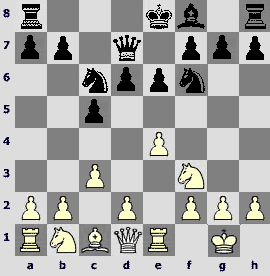
8.d3. White scared the opponent with the move d4 but as a result he made a blank shot – only unpretentious d3.
8...Ґe7 9.¤bd2 0–0 10.¤f1 ¦fd8. At the rapid-tournament in Tallin Miroshnichenko played differently: 10...b5 11.d4 d5 12.¤e5 Јb7 13.¤xc6 Јxc6 14.e5 ¤d7 15.Јg4 ¦fd8 16.Ґg5 Ґf8 17.h4 ¦ac8 18.h5 b4 19.¦e3ѓMorozevich – Miroshnichenko, Tallin 2003, though in this case Alexander also managed to achieve a good position.
11.¤g3 ¤e5 12.¤g5!? A move ¤c3 can be called a Morozevich move. So it is possible to nickname this maneuver "the pirouette of Morozevich" without a twinge of conscience, though it wasn't success in this game.
12...c4. Black forcibly obliges White to define the structureThe pirouette worked well after 12...h6 13.¤h3!
13.d4 ¤d3 14.Ґe2 b5
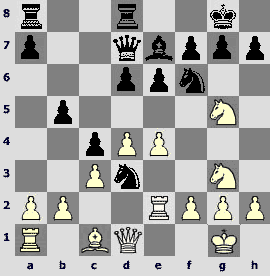
Black starts the action on the queenside. 14...d5!? 15.e5 ¤e8 16.¤f3›.
15.¤f3. After standing on g5 for some time, the White's knight calmly returns.
15...b4 16.¤e1 bxc3 17.bxc3 ¤xc1. Black exchanges the knight for the bishop according to all the laws. 18.¦xc1 ¦ab8. The rook is on the open file. 19.¤f3. And what do you think about it? The king's knight of White rushes about the refuge.
19...d5. Black opens his bishop and rids himself of any e4-e5 pushes, however, he also gets under tempi. 19...¦b7!?
20.¤e5 Јb7?! Evgeny chooses not the best retreat square. The Black's queen lets its counterpart to an excellent square and prevents the rooks of invading via the b-file. 20...Јb5!?; 20...Јc7!?
21.Јa4! ¦dc8 22.f3
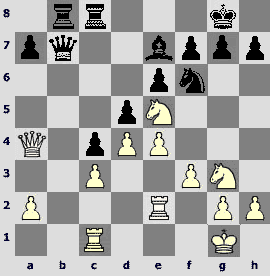
Morozevich continues playing in dry, academic and maneuvering style. Black is presented with a large amount of tempos. The White's non-concrete unhurried play makes an impression. It is very important that Black has neither attacking objects nor any clear plan.
22...Ґf8. Playing a firmer 22...Ґd6!? probably made sense.
23.¦f1 ¦c7 24.Јc2 g6?! Surprisingly, this move seriously weakens the position of the Black's king. 24...Јa6!?
25.Јc1 Јc8 26.¤h1! An excellent way of activating the knight.
26...Јa6. This move speaks for itself. It is difficult for Black to play such viscous chess.
27.¤f2 Јa3 28.Јf4 ¤h5 (a more solid-looking 28...¤e8 is strongly met by a 29.¤xf7! blow) 29.Јe3 ¦cb7 30.exd5 exd5 31.f4
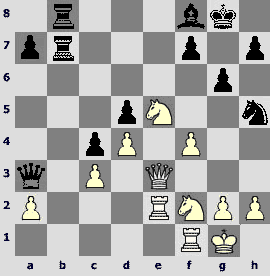
Now the weakening on the twenty-fourth move tells.
31...¦b1 (31...Јd6!?) 32.¤d1. That's where the g3-knight was going! 32...Јa4 33.¦ee1 f5. A desperate attempt to build a barricade doesn't work.
34.g4 ¤g7 (34...fxg4? 35.¤xg4 ўh8 36.¤e5ѓ) 35.Јf3. Black fortifies on f5 – White probes another weakness on d5.
35...¦d8 36.¤e3. The White's knight unexpectedly comes out to an excellent square with a tempo. 36...¦xe1 37.¦xe1 Јa5 38.¦d1!±. The position rapidly turned from unclear into highly favorable for White.

38...fxg4? The last error. Better is38...¦d6 39.gxf5 ¤xf5 40.¤xf5 gxf5 41.ўh1±.
39.¤3xg4ќ. There is no defence against both the mate and the fork on c6. 39...¤f5 40.¤c6 1–0
A.Morozevich (2758) – A. Korotylev (2596)
Moscow 2004

The previous sixty moves the players were dancing over the equal position. While commenting his game with Grischuk, Korotylev noted that in the previous round (against Morozevich) he could make a draw several times from the position of strength. It is for the descendants. The game was won by Morozevich.
62...Јc5?? 63.Јxc5 bxc5 64.ўd5 1–0. I dare to suppose that not every elite chess player could make a rather skilled opponent commit such an error.
There already was a tournament in the Muscovite's career that had to be won. In a word, he took part in a qualifying stage of the World championship 2002. That tournament in Dortmund was carried out by a formula of the tennis tournament "Master's cup". After a vexing defeat in the first round by Evgeny Bareev, Alexander started returning his play gradually, but the distance was short – six games. It is necessary to win, but there are still no victories. And here comes the final round. It is a drama by definition. One has to defeat a compatriot who is content with a draw.
E.Bareev (2726) – A.Morozevich (2716) A00
Dortmund 2002
1.d4 g6. Such is the custom that positions with the Black's bishop on g7 are the most suitable for Black to break the defense of the opponent who is satisfied with a draw.
2.g3 Ґg7 3.Ґg2 c5 4.c3. The second and the fourth moves of White tell much about his motivation.
4...Јa5!? 5.¤d2. Probably, it is stronger to play 5.d5 d6 6.e4 ¤f6 7.¤d2 0–0 8.¤c4 Јc7 9.a4 ¤bd7 10.¤e2 ¦b8 11.0–0 b6 12.Јc2 Ґa6 13.¤a3 ¦be8 14.¦d1 Ґb7 15.a5 a6 16.axb6 ¤xb6 17.c4Іўarpov – Istratescu, Bucharest 2005.
5...cxd4 6.¤b3 Јb6 7.cxd4 ¤f6 8.d5
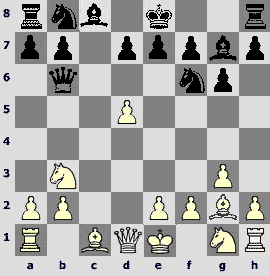
Maybe, this move is too sharp. After it Black has a clear play and simple arrangement of pieces. 8.¤f3!?
8...d6 9.¤f3 0–0 10.0–0 ¤a6!¤. A logical novelty. The Black's knight goes to c5 without staying in a way of the c8-bishop.
11.¤fd4. White centralizes his knight and "hangs" it at the same time.11.Ґe3 Јb5 12.¤fd4 Јa4„.
11...Ґd7 12.Ґd2. It was possible to put the bishop on e3 but it gave too many tempos to Black: 12.h3 ¦fc8 13.Ґe3 Јb4 14.¤c2 Јa4ѓ.
12...¤c5 13.Ґa5. This move is active but a bit flabby. The White's pieces begin feel painfully loose.13.¦c1 ¦fc8і.
13...Јa6 14.Јd2 ¦fc8і
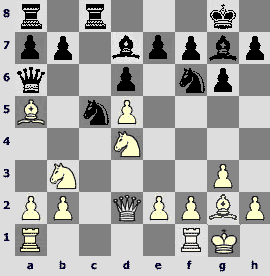
It is possible to sum up the opening. Black has better chances and I don't see any counterplay ideas for White. . I don't think Evgeny Ilgizovich could end up in such position if he wasn't satisfied with a draw.
15.¤xc5. By this moveWhite gives absolute freedom of action to Black. 15.¦fc1!?
15...¦xc5 It was quite possible to play 15...dxc5!? 16.¤c2 Ґf5 17.Ґc3 Ґe4і 16.¤b3. If 16.Ґb4 than Black could react even by 16...¦xd5!? (16...¦c7)17.Ґxd5 ¤xd5©.
16...¦c4 17.¦fc1 ¦xc1+! Animportant nuance. White can't take with a heavy piece.
18.¤xc1 (18.¦xc1? b6 19.Ґc3 Јxa2 20.¤d4 ¤xd5 21.¤f5 (21.¤b3 e6!?і) 21...Ґxc3 22.Јxd5 Јxd5 23.¤xe7+ ўf8 24.Ґxd5 Ґxb2 (24...¦e8!?) 25.¦c7 ¦e8µ)
18...¤g4!? (18...¦c8 19.Ґc3 Јc4ѓ) 19.¤d3. It was also possible to drive away a strong dark-squared bishop but it wouldn't improve the position – 19.Ґc3 Ґxc3 20.Јxc3 ¦c8 21.Јd2 ¤e5і.
19...¦c8 20.h3 ¤e5 21.Ґc3. It is a sensible striving for the exchanges. 21.¤xe5 Ґxe5ѓ.
21...¤c4. Black could have been satisfied with the advantage in a more simple position – 21...¤xd3!? 22.exd3 Ґf5 23.Ґxg7 ўxg7і.
22.Јg5!? The position has simplified. White has to play actively in order not stay face-to-face with his weaknesses. 22.Јe1 Ґxc3 23.Јxc3 (23.bxc3 Јa5µ) 23...¤e5ѓ.
22...Ґxc3 23.Јxe7
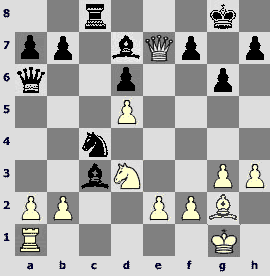
After 23.bxc3 f6і Black's advantage would be comfortable.
23...¤xb2. Black chooses the strongest and the safest of all possible ways. 23...Јa4 24.bxc3 ¦e8 25.Јf6 ¦xe2 26.¤f4„; 23...Ґxb2 24.¤xb2 ¤e5 25.¤d3 ¦e8 26.Јf6 ¤xd3 27.exd3›.
24.Јxd7 ¦f8 25.¦c1? It seems to be an error. The exchange of knights led White to a worse endgame with opposite-colored bishops – 25.¤xb2 Ґxb2 26.¦f1 Ґe5!? 27.e3 Јxa2 28.Јxb7 a5і; stronger is 25.Ґe4!?
25...¤xd3 26.¦xc3 If 26.exd3, then comes little bit of tactics 26...Јxa2!µ 26...¤e5 27.Јc7 Јxe2. White is getting annihilated.
28.¦e3 28.Ґf1 Јe4 doesn't help. 28...Јxa2 29.Ґf1. An unclear move. It seems that both players were short on time. 29.Јxb7 a5µ.
29...Јxd5°
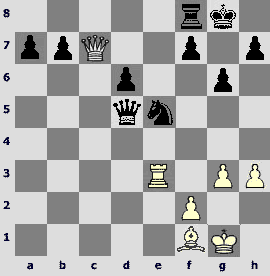
30.Ґg2 Јd1+ 31.ўh2 Јd2 32.ўg1 ¤d3 33.¦f3 ¤e1. Why not to transit to an endgame with three extra pawns? 33...Јc1+ 34.Јxc1 ¤xc1. Of course, the location of the knight isn't excellent. It is clear that Black will have to give away a pawn. But Morozevich had three extra pawns!!! 35.¦a3 b5 36.¦xa7 ¤e2+ 37.ўh2!?µ (37.ўf1 ¤c3 38.¦c7 b4 39.¦b7 ¦a8).
34.¦f6 Јd1“. In my opinion, Evgeny Il'gizovich said something like: "After 34...¤xg2 I would prepare for a handshake
35.Ґxb7 d5?! 36.ўh2
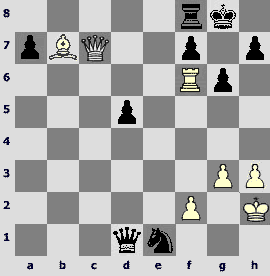
36...ўg7? This move loses! There still was a way to win: 36...Јb3! 37.Јe7 ¤f3+ 38.ўg2 ¤e5µ.
37.Јe5 ўg8. White threatened with a discovered check: 37...¦d8 38.¦e6+ ўg8 39.Јxe1ќ.
38.Ґxd5ќ¤d3 39.Јe7 Јe1 40.Ґxf7+ 1–0. The nervous tension was in every move of both players.
Brave new world. It is so old...
The journalists often speak about a so called "Morozevich's rebellion". I will explain this intricate term – they speak about Alexander's play that does not match modern standards, about the absence of clichés in his play, about the successful avoidance of the theory in our computer epoch when you can't be called a chess player if you hadn't prepared your first fifteen moves at home. Another distinguishing feature of Morozevich is his epatage play for the public in the manner of old masters. A wish to play more spectacular often adversely affects the number of the points collected. However, firstly, there is a saying "the impossible is possible if you want it badly"; secondly, the audience is always pleased; thirdly, Victor L'vovich noted that a spectacular and unexpected move often demoralizes the opponent, or at least, breaks the rhythm of his play for some time.
A.Morozevich (2741) – V.Anand (2786)
Wijk aan Zee2005
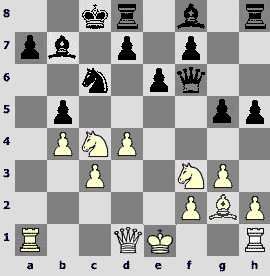
16.0–0!? There is nothing to comment. Everything is seen on the diagram.
16...bxc4 17.b5 ¤b8 18.¦xa7 d5 19.¤e5 ¦d7! It is a comfortable defense in Anand style. The fakir is ready to give up the exchange to provide safety for his king. Especially because the knight on e5 is very active and Anand doesn't grudge a rook for it.
20.Јa4 Јd8
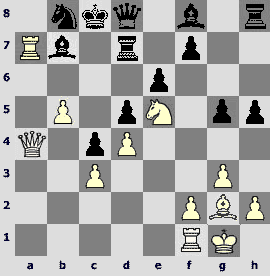
21.¤xc4! Absolutely correct defiance of the material. A clumsy 21.¤xd7 gives nothing to White – 21...Јxd7 22.¦a1µ, and it isn't easy to invent the next move. I don't speak about the subsequent threat either.
21...dxc4 22.Јxc4+ Јc7 23.Ґxb7+ ўd8 24.Јe2? It is necessary to keep the queens on board in order to stir up the situation. Everything is right but not in this case. It is paradoxical but the exchange of the queens could give good practical chances: 24.Јxc7+ ¦xc7 25.¦c1›, and the position is unclear. For instance, 25...¤d7 (25...Ґb4? 26.c4 Ґa5 27.¦xa5 ¦xb7 28.c5І is simply bad)26.¦ca1! ,
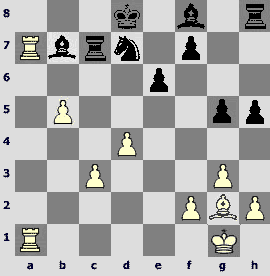
and the c3-pawn is poisoned.
24...Ґd6. Black covers the e5-square. Јb6 is a threat. 25.¦fa1 Јxc3 26.d5 ¦xb7!°
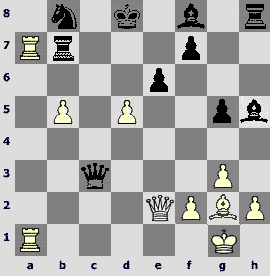
The last finesse. Alexander scarcely blundered it. There was nothing to be done.
27.dxe6 ¦xa7 28.¦xa7 fxe6 29.¦xe6 Јe5 30.¦e7. Everybody loses in a different way. Some do it calmly, others do this having no other chances, and there are players who break chairs... Our hero loses bravely and in spectacular fashion.
30...Јa1+ 31.Јe1 Јxe1+ 32.¦xe1 ¤d7 33.ўg2 ¤c5 34.¦d1 ўd7 35.¦d5 ¤e6 36.ўf3 ¦f8+ 37.ўe2 ўe7 38.h4 g4 39.¦xh5 Ґc5 40.¦e5 ¦xf2+ 41.ўd3 ўf6 0–1
I don't know exactly how to put it but in my opinion many of Alexander’s lost games have the same feature as Dostoyevsky's books – there is certain anguish in them. And the last idiotic association – please have patience. In Germany there is a football club that is one of my favorite in the world. It is "Werder Bremen". These guys are absolutely reckless. Malice and reckless bravery – these two characterize them best of all. Usually they win like 4-3 or something in this spirit and the victory 6-1 has never been a unique occurrence for the wards of Thomas Shaaf. But the trouble is that the "musicians" let through goals almost in every match. So it is very difficult for them to beat top-class teams with such an impudence (ducks). Well,back to the game
I.Sokolov (2685) – A.Morozevich (2741) D08
Wijk aan Zee 2005
1.d4 d5 2.c4 e5 3.dxe5 d4 4.¤f3 ¤c6

5.¤bd2
5.a3 ¤ge7 6.b4 ¤g6 7.Ґb2 a5 8.b5 ¤cxe5 9.¤xe5 ¤xe5 10.e3 Ґe6 11.Ґxd4 ¤xc4 12.Јc2 ¤d6 13.Ґd3 Јg5 14.f4 Јh4+ 15.g3 Јh5 16.¤c3 ¤f5› Topalov – Morozevich, Monte Carlo 2005;
5.g3 ¤ge7 6.Ґg2 ¤g6 7.Јa4 Ґb4+ 8.¤bd2 0–0 9.0–0 a5 10.a3 Ґe7 11.¦d1 ¤cxe5 12.¤xe5 ¤xe5 13.¤f3 ¤xf3+ 14.Ґxf3 Ґf6 15.c5 Јe7 16.Ґf4 g5 17.Ґd2 c6 18.Јc2 a4„ Khenkin – Morozevich, Mainz 2005.
5...¤ge7 6.¤b3 ¤f5 7.a3 Ґe7 8.g3?! (8.Ґf4!? a5? (8...f6!?)9.g4!) 8...a5 9.Јd3 a4 10.¤bd2
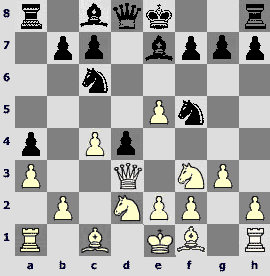
10...h5?! (10...¦a5!?; 10...0–0!?) 11.Ґh3 g6 12.¤e4 h4 13.Ґf4 (13.g4!? ¤g7 14.e3 ¤e6©) 13...hxg3 14.hxg3 ¤g7
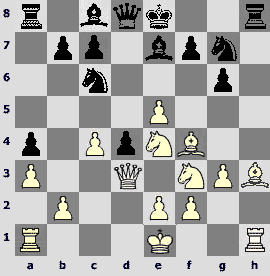
15.Ґg2? (15.¤f6+! Ґxf6 (15...ўf8 16.¤h4!±)16.exf6 ¤e6 17.Јe4 Јxf6 18.Ґxc7І) 15...¦xh1+ 16.Ґxh1 Ґf5„ 17.¤fg5 (17.0–0–0 ¤e6ѓ) 17...¤a5 18.Јf3?! (18.¤h7!? ¤e6 19.0–0–0 c6›) 18...¤e6
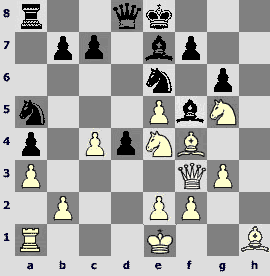
19.¤h7?! (19.¤f6+!? Ґxf6 20.exf6 ¤xg5 21.Ґxg5 c6›) 19...Ґxe4 20.Јxe4 c6і 21.e3? ¤b3µ
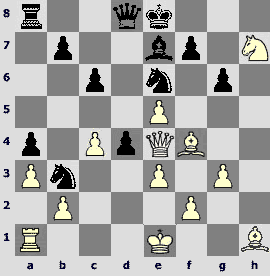
22.¦d1 Јa5+ 23.ўe2 ¤ec5 24.Јg2 Јa6 25.ўf1 Јxc4+ 26.ўg1 Јc2 27.Јf3 d3 28.Ґg5 ¤e4!°
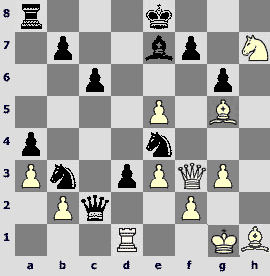
29.Ґxe7 ¤xf2 30.Јxf2 Јxd1+ 31.ўg2 Јc2 32.Ґd6 0–0–0 33.ўg1 Јxf2+ 34.ўxf2 ¦h8 0–1
The author used comments by V.Atlas, A.Vaisser, V. Gagarin, V.Epishin, A. Morozevich, L.Psakhis, P. Wells, L. Ftacnik, A. Huzman, R. Hübner, I. Stohl.
